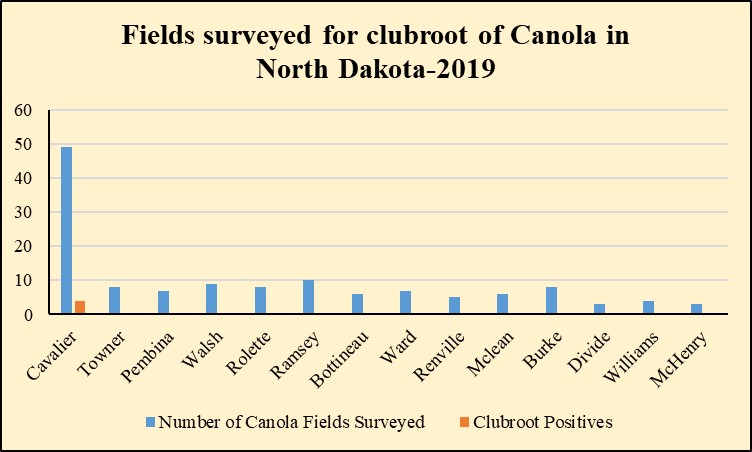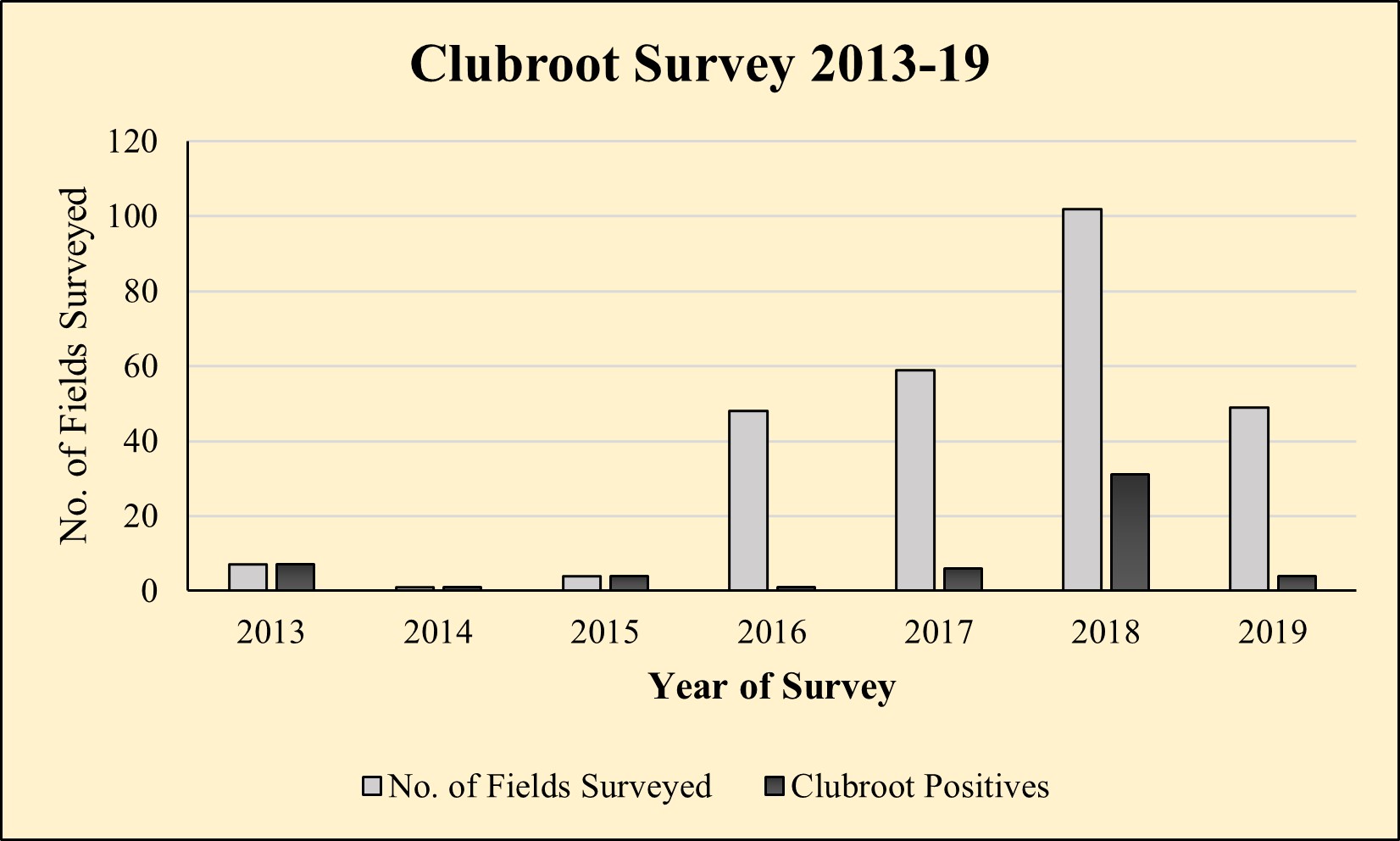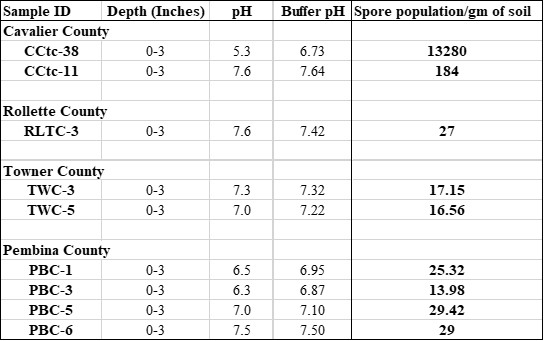Project Title: Survey and Creating Awareness on Identification and Management Plan of Clubroot of Canola in Northeastern North Dakota
Survey Procedure: The survey involved two components: 1. Visual Survey and soil sampling and 2. Molecular assays for clubroot identification and resting spore quantification of clubroot pathogen.
Note: The ongoing clubroot survey program has been conducted for over four years in various counties of North Dakota. Survey results indicate a threat to the canola crop if proper attention is not given towards longer crop rotations (canola only once in 3 years) and equipment sanitation.
Component 1. Visual Survey: Clubroot scouting was done visually by inspecting canola crop roots. The disease survey was conducted in northeastern counties (Pembina, Walsh, Ramsey, Towner, Rolette and Cavalier) along with North Central and Western counties of North Dakota that are bordering Canada. County selection was based on canola acreage, bordering Canada and on the assumption of clubroot propagules movement in all directions through equipment, soil or water to neighboring counties from Cavalier County. In each county, one field in every 5,000 acres was targeted for scouting. Soil samples were collected from the positive and likely positive clubroot fields with an intent to determine how high the pH of the soil in which clubroot is present. In all, a minimum of 5-10 fields per county were targeted for scouting.
The survey was done in two phases.
1st phase: at flowering (10% of flowering onwards)
In the growing season, plants were sampled from distinct stunted patches or prematurely senescing plants in the field. Patches visible from the edge of the field were checked by digging plants and observing the roots for symptoms of clubroot and soil samples were collected.
2nd phase:
After swathing:
The scouting at swathing was based on the methodology followed in Canada by the Alberta Agricultural and Rural Development (AARD) for clubroot disease survey. Reports by AARD indicate that the incidence of clubroot is greater in the field entrances. The survey was done from the main entrances/approaches in a field. The survey group walked in a “W” pattern, stopping at 10 spots and uprooting 10 consecutive stems from the ground at each spot. Each sampling point was separated by 100 meters or 328 feet. In all, roots of 100 stems were evaluated for the presence of clubroot and incidence was noted. Excess soil was shook off. Roots were visually examined for the presence of galls. At sample sites where infection was observed or suspected, root specimens with galls and soil were double bagged and labeled with the field location. The soil samples were collected at a depth of three inches at five sites by walking in a “W” pattern. Infected roots were air-dried then stored long-term at -20o C. The soil samples from all the fields surveyed were submitted to Dr. Luis del Rio’s laboratory for molecular assays to quantify resting spores of the clubroot pathogen and to the NDSU Soil Testing Laboratory for pH determination.
Figure 1: Fields surveyed in 2019 for prevalence of clubroot in various counties of North Dakota.
Figure 2: Fields surveyed from 2013 to 2019 for prevalence of clubroot in North Dakota
Component 2. Molecular assays for clubroot identification and resting spore quantification of clubroot pathogen.
Annual surveys of clubroot indicate that the disease is spreading faster than expected. The objective of this procedure is to quantify resting spores of clubroot pathogen in soil and to inform growers before occurrence of field visible gall symptoms in canola. The NDSU canola pathology program led by Dr. del Río has the capability to perform laboratory tests to verify clubroot presence in soil samples. This has been possible by molecular assays that have been conducted by Dr. Chittem (Research Scientist) working at Dr. Luis del Rio’s lab in Fargo, ND. We encourage growers to submit soil samples for quick confirmation of clubroot.
Results of 2019 soil samples:Identifying clubroot infested fields with molecular assays indicate that the disease on canola has been spreading to neighboring counties (Table 1). However, no visible symptoms have been observed on the roots. Positive identification of clubroot in the molecular assays of soil samples with no visible galls in the surveyed fields could be due to the resting spore population has not reached the required spores per gram of soil to express infection. In general, clubroot infections express on canola plants when spore populations are about 80,000 per gram of soil. Until then there will be no expression of clubroot symptoms on canola roots (Canadian Research).
Table 1: Clubroot positive fields observed in neighboring counties of Cavalier County.
Notice: Growers who suspect clubroot in a field(s) are encouraged to contact Dr. Venkat Chapara at the Langdon REC (701-256-2582), Dr. Anitha Chirumamilla at the Cavalier County Extension Office (701-256-2560), Dr. Luis del Río in the Department of Plant Pathology (701-231-8362) or NDSU Extension (701-231-8363).
In addition, growers should consider practicing longer crop rotations in clubroot-identified fields and planting once in three years with an available clubroot resistant canola variety. Clean equipment thoroughly after working in a clubroot-infected field since the primary mechanism of spreading between fields is the movement of infested soil on farm equipment. Yield losses were recorded up to 25% in severely infected canola fields in Cavalier County in 2018. The fields where clubroot occurred had acidic soils but were approaching basic pH, 7.0 or greater.
In all 133 canola fields have been scouted in 2019 in various counties of northern North Dakota, of which four fields in Cavalier County are positive to clubroot for visual symptoms survey. Nine fields were found positive for clubroot through molecular assays in four counties. Three counties (Pembina, Towner and Rolette) have been identified for the first time with clubroot resting spores in the soils. Clubroot resting spores that were quantified from those samples ranged from 16 to 13,280 per gram of soil. The pH of clubroot positive fields with visual symptoms ranged from 4.5 - 6.7. Molecular assays detected spores in soil pH of 7.64. However, there were no visible symptoms of clubroot. These results indicate an immediate need to test soil samples from fields of all canola growing counties in North Dakota to predict clubroot infections earlier and to follow management options.
Acknowledgements: Many thanks to the growers and collaborators from North Dakota and Minnesota. Special thanks to the support given by all the funding agencies: Northern Canola Growers Association, State Board of Agriculture Research and Education, ND Crop Protection Product Harmonization Board, and the Northern Canola Research Program (NIFA/USDA).


